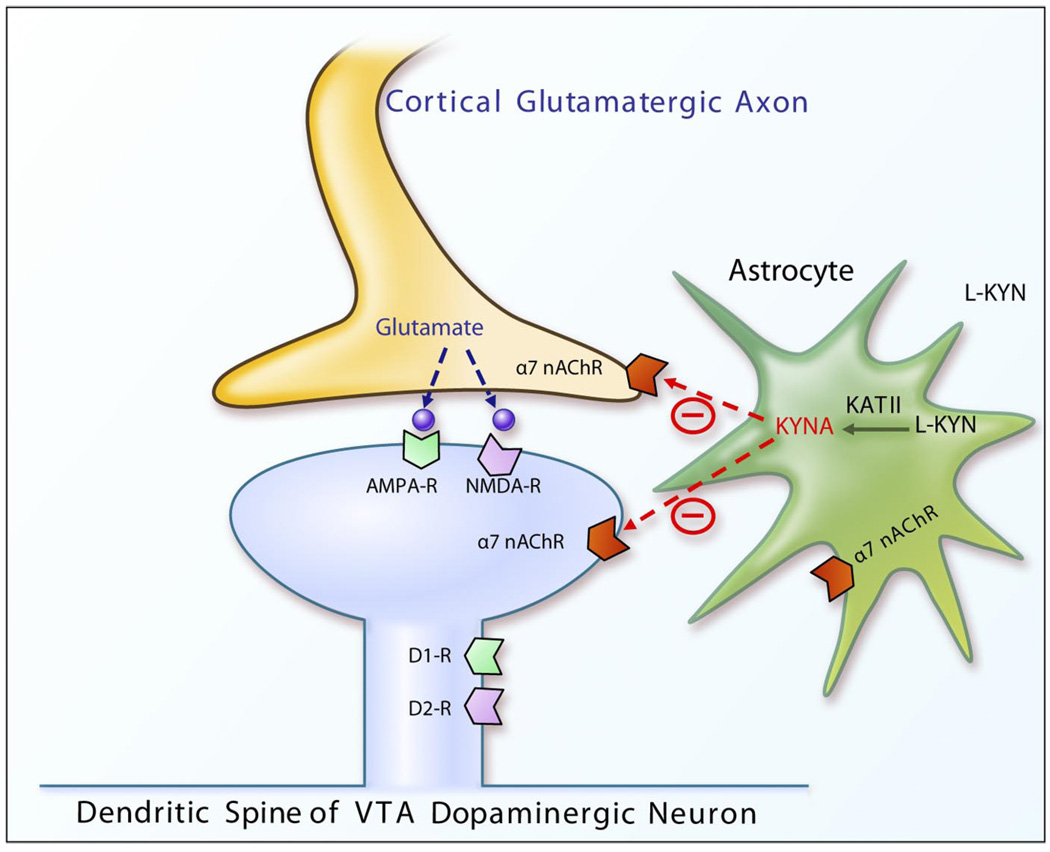FIG. 8.
Role of astrocyte-derived kynurenic acid (KYNA) in regulating the activity of dopaminergic neurons in the ventral tegmental area. This simplified scheme illustrates the role of astrocyte-derived KYNA in modulating synaptic transmission between a cortical glutamatergic axon and a dopaminergic neuron in the ventral tegmental area (VTA). The VTA supplies dopaminergic inputs to several nuclei in the so-called reward circuit. This circuit, which is centered around the nucleus accumbens and is critical for animals to display goal-directed behaviors, has been shown to be strategically positioned to relay information about motivation, drive, and affective state to motor systems. Dopaminergic activity in the nucleus accumbens has an essential role in the functioning of this circuit. The reinforcing properties of drugs of abuse, including nicotine, are associated with increased dopaminergic activity in the nucleus accumbens, which receives dopaminergic inputs from the VTA. The nucleus accumbens receives input from several limbic structures, including the amygdala, the hippocampus, and the medial prefrontal cortex and innervates the ventral pallidum, subpallidal area, and substantia nigra, which provide inputs to motor structures. The dopaminergic activity in the nucleus accumbens is, thus, regulated by local integration of various neurotransmitter systems originating in different areas of the brain. However, it is also controlled by the cortical glutamatergic input to the dopaminergic neurons in the VTA. Local infusion in the rat striatum of a kynurenine hydroxylase inhibitor has been shown to increase extracellular levels of dopamine, which were decreased by the addition of KYNA to the perfusate (390, 391). The association between low levels of KYNA and increased levels of dopamine has also been observed in mice with a null mutation in the gene that encodes the KATII enzyme (516). Thus it is tempting to speculate that dopaminergic transmission in the striatum is regulated by astrocyte-derived KYNA. VTA dopaminergic neurons are known to express somatodendritic α7 nAChRs and to receive excitatory inputs from cortical glutamatergic terminals that express α7 nAChRs. Activation of these receptors stimulates dopamine release into the nucleus accumbens within the striatum. It is plausible to hypothesize that endogenous KYNA released from astrocytes may inhibit tonically active α7 nAChRs and, thereby, decrease dopamine levels in the striatum. This emphasizes the concept of tripartite synapses in the brain, whereby synaptic activity is tuned by astrocyte-derived regulatory signals (480).

